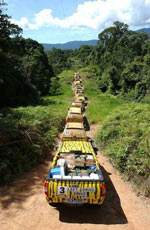 In
the upcoming two days we have a new challenge as the tiger-print
convoy heads from Cairns in Central Queensland - a drive
of 1,500km. The difficulties anticipated with this type
of driving are different than those in the earlier part
of the expedition: this section means drivers need to stay
behind the wheel longer than normal so regular reaks are
needed. It's a journey that needs lots of concentration,
so drivers swap shifts often for rest periods.
In
the upcoming two days we have a new challenge as the tiger-print
convoy heads from Cairns in Central Queensland - a drive
of 1,500km. The difficulties anticipated with this type
of driving are different than those in the earlier part
of the expedition: this section means drivers need to stay
behind the wheel longer than normal so regular reaks are
needed. It's a journey that needs lots of concentration,
so drivers swap shifts often for rest periods.
An additional
challenge is that the vehicles' gas tanks will require topping
up along the way and since gas stations are few and far
between on this route, we carry all the gasoline we need
on our roofs.
Our
already heavy vehicles are now at their maximum load capacity.
We worry so much about running out of fuel that even people
in the last vehicle of the convoy hear the sighs of relief
coming from the first one as a gas station in the town of
Winton comes into view. We made it.
This
long journey also brought with it constantly changing scenery.
One of the more amazing things was Mastering -: the gathering
up of cattle from thousands of acres into one group. Mastering
is done by cowboys riding horses, motorcycles, tractors
and flying in helicopters and aeroplanes while more than
1,500 cattle pass between the Isuzu vehicles. As far as
I am concerned, the wild, wild west is right here and now.
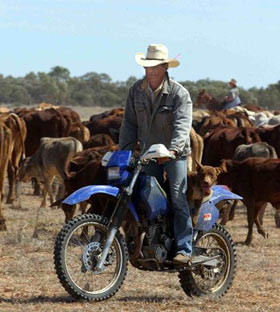
After
the first day we have successfully covered 750 km. and go
to sleep well after midnight. The next morning, many new
sights await us: the desert is replaced with thick eucalyptus
forests. Our main challenge here is not to
run over any kangaroos on the way! They jump around us from
all directions and we are constantly warned over the walkie-talkies
to keep a look out for them.
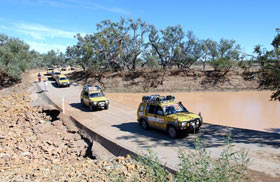
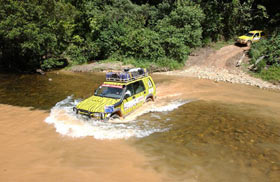
At a
quick rest stop we discover that the men's restroom has
a sign on the door: "bulls" and the women's, "cows".
I guess this is fitting considering that the main source
of income for this area is from cattle.
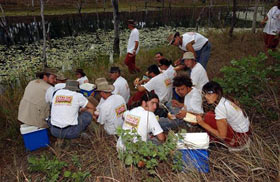
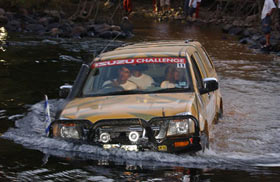
A huge
black mass in the road makes us all stop suddenly - we discover
a huge snake, 2 meters long. A few minutes later, when we
sit to have lunch surrounded by termite nests, I ask myself
if it is wise to sit on the ground
in this spot - but hunger takes over and I continue eating,
sitting where I am while Eti the guide explains the important
ecological role of termites in breaking down dead vegetation.
We are surprised to learn that the queen
termite lays more than 20,000 eggs in one day. Imagine,
20,000 babies!
Just
before dusk it begins to rain and we stop to see the 150
meter high Blanco Falls. They are impressive. The rain adds
to the feeling of power that the waterfall gives as it flows
down. At the campsite everything is in place. We have covered
1,500 km in just two days.
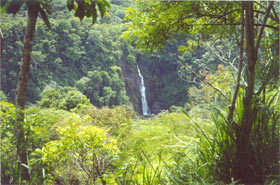
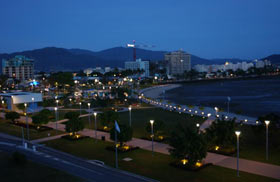
Photographer
: Gerry Avramovich